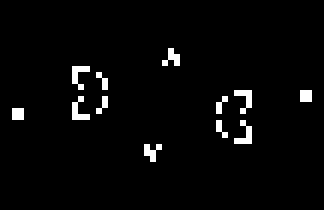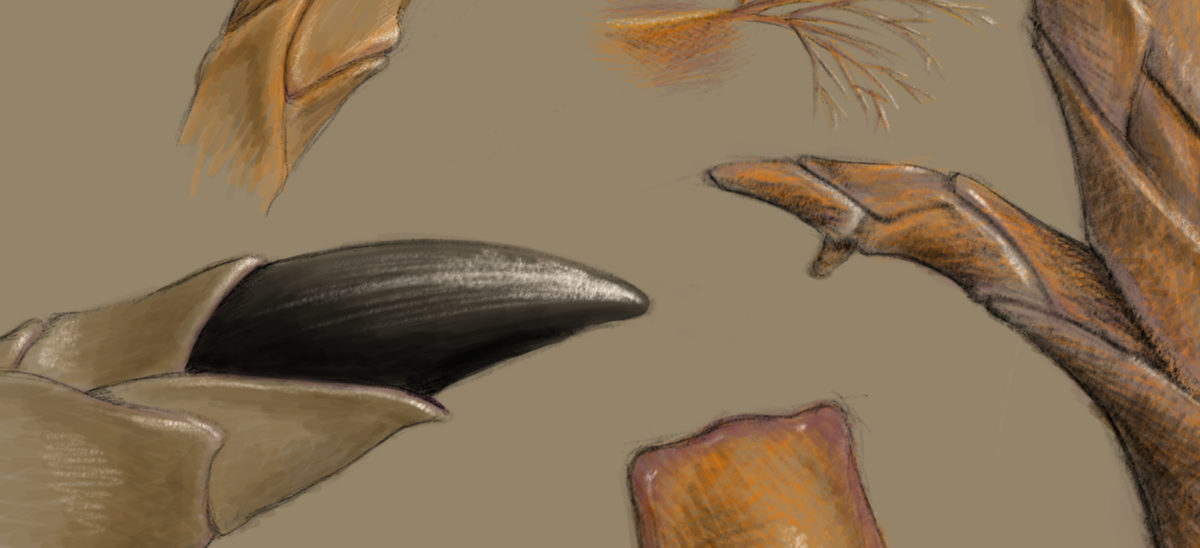What might physiology look like if a creature has no circulatory system or other differentiation with which we’re familiar? How might that affect its methods of reproducing? Its social life? Its evolutionary process, itself? Let’s explore the idea a little with this modular, fractal critter I’m calling the Phia. Or at least some pieces of it.
…which is much the same as the whole.

Genetics
Several factors go into the morphology of a particular Phia. The first, of course, is its genes. Like stem cells, each of these ravioli-shaped elements, or module, contains a complete set of genes. Those genes carry instructions for making the basic shape, for making the coboglobin that transports oxygen around the body, for an energy storage organ and rudimentary metablism, for how to grow, and then how to develop the electrochemical system by which it communicates and shares energy with its neighbors.
Communication

Then, by sensing the state of neighboring modules, it turns on and off varieties of genes that express physical changes — changes like developing touch and chemical senses, changing hardness of their outer material, changing the oxygen availability of the coboglobin, and other physiological and biochemical needs.
Modularity
Modules vary in size, following a Fibonacci sequence. The smallest, 1:1 modules can be found in the air-gills that the creatures uses to adhere oxygen to coboglobin in order to transport it around its body. (see illustration, top center and top right.) These modules have a rough texture to maximize their surface area and grow with gaps between them, allowing the fragile structures both spaceframe-like strength and greater surface area.
Other modules wrap themselves into Fibonacci spirals, like the palp at the top left or the claw on the bottom left. Note that highly-oxygenated organs like the gills or the highly sensitive organ structure are a gold color, rimmed with pinkish purple. The gold color is oxygenated coboglobin, while the purple is the color of the structural material, as deoxygenenated coboglobin is transparent.
Metabolism
Like the chemical forms of life with which we’re familiar (e.g.: you), energy comes from making and breaking chemical bonds, the primary candidate for which is oxygen (though other chemistries might be possible). In Phia, oxygen is passed from one coboglobin molecule to the next in relay, rather than the coboglobin, itself, circulating. This process, by our standards, is slow and inefficient. It is, however, lightning fast by the evolutionary standards on the planet where they grow. Evolution doesn’t care if a solution is good, after all. It only cares if it’s working right now.
Coboglobin “wears out” much faster than our own hemoglobin does. These creatures excrete used-up coboglobin and other waste products onto a symbiotic organism that gains energy from the sun, “refreshing” the molecules and gaining a margin of surplus energy in the process. That same, symbiotic organism grows roots into the soil, pulling cobalt into the ecosystem from the geological processes that bring it toward the blue soil of the planet.
Reproduction
Reproduction is performed by sharing modules refined into reproductive packets. There is no sexual heteromorphism at all among Phia, as there are no dedicated organs at all. Rather, any number of mates share in the creation of a new individual, based on sexual selectors.
There are two kinds of information shared between generations among Phia. The first is their genes: a record of instructions about producing more complex chemical compounds, as in our proteins. These compounds form the basic, biological infrastructure for the creature.
The other kind of information passed between generations is the experience encoded in each module, including the body form of its immediate ancestor. That encoding allows for a Lamarckian form of evolution in the short term; an epigenetic allowance that has given this species the advantage of more rapid adaptation than the genes-only members of its ecosystem.
To reproduce, any number of individuals combine their reproductive packets to build the core of a new individual. The new Phia then begins to differentiate its modules into new structures, starting with respiration and metabolism, with its feeding and breathing aided by others it its community. Because the reproductive packets carry with them encoded experience in addition to genes, newborns (newbuilts?) are fairly precocial, though they are physically unable to hunt or forage with their initial, rudimentary organs, and so, must be fed until they can grow enough modules to explore on their own.
I can make weird body parts because you, my subscribers, back me on Patreon. If you’re not doing so and like my work, please subscribe, as well! You should also check out The Fifth World, who help sponsor xenoglyph.

